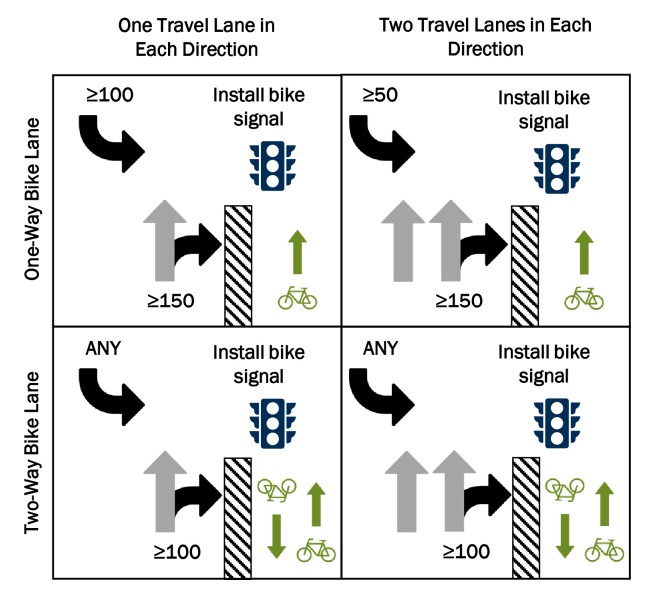18.3.12 Intersection Elements
18.3.12.1 Bicycle Crossing / Conflict Markings
Where a bike lane crosses an intersection separate from a crosswalk, bike lane markings may be extended through the intersection to delineate the bicycle crossing. Bike lane crossings are desirable to:
- Delineate a preferred path for people bicycling through the intersection, especially a crossing of a wide or complex intersection;
- Improve the visibility and recognizability of the bike crossing to roadway users; and
- Encourage motorist stop or yielding behavior, where motorists must merge or turn across the path of a bicyclist or pedestrian
provides design details for various bike crossing scenarios.
Where marking the conflict area is desirable, a dotted white edge line should be used to delineate the bicycle lane extension through the intersection by marking the left and right edge of the bicycle lane. The dotted lines are 2- ft in length with 2-ft to 6-ft gaps located on the edge of the bike lane. Normal width (6-in) or wide lane line widths (8-in) may be used, but they should typically match the width of the bike lane lines. Conflict area visibility may be enhanced with green-colored pavement and a bicycle lane symbol. If used, green-colored pavement should generally match the pattern of the dotted edge lines but may be solid where additional emphasis of the crossing is desired (see
for conditions of allowed use of green-colored pavement marking).

Figure 18-12: Bicycle Crossing Pavement Markings
(Refer to the
and
for additional signing and pavement marking guidance.)
18.3.12.2 Bicycle Signals
At signalized intersections, bicyclists may be controlled by motor vehicle signals, pedestrian signals, or bicycle signals. A bicycle signal provides a separate indication for the exclusive use of bicyclists. The use of a bicycle signal requires a “[BICYCLE] SIGNAL” (Signs R10-40 or R10-41) sign installed immediately adjacent to the traffic signal. Bicycle signals are typically used in the following situations:
- Two-way separated bike lanes;
- One-way separated bike lanes where the right-turn or left-turn motor vehicle movements across the separated bike lane exceed the thresholds in ;
- Where bicyclists’ position in the bikeway does not allow them to see motor vehicle or pedestrian signals that may otherwise be able to control their movement; and
- Where intersection complexity is such that signals are helpful, as determined by engineering judgment.
Bicycle signals can use a standard vehicle signal head with the R10-40 or R10-41 sign(s) or may use a signal with bicycle signal faces that comply with the requirements in FHWA’s Interim Approval (IA)-16. However, IA-16 has a specific requirement that bicycle signal faces may only be used if all bicycle movements are protected. An approved Request to Experiment from FHWA is needed for locations where permissive turns are allowed across a bike lane controlled by bicycle signal faces. Refer to the
for additional guidance on the use of Bicycle Signal Faces.
18.3.12.2.1 Considerations for Phase Separation
Designers should assess the number of right or left-turning motorists across sidepaths, raised bike lanes, or separated bike lanes which are physically separated from adjacent motorists during the peak hour to identify if permissive turns should be considered to manage potential conflicts which can arise due to their physical separation at the intersection.
identifies the thresholds where signal phase separation between bicyclists and turning motorists is recommended, but other factors such as the intersection complexity, number of signal phases, and engineering judgement should guide the designer’s decisions.

Figure 18-13: Signal Phase Separation of Turning Motorists